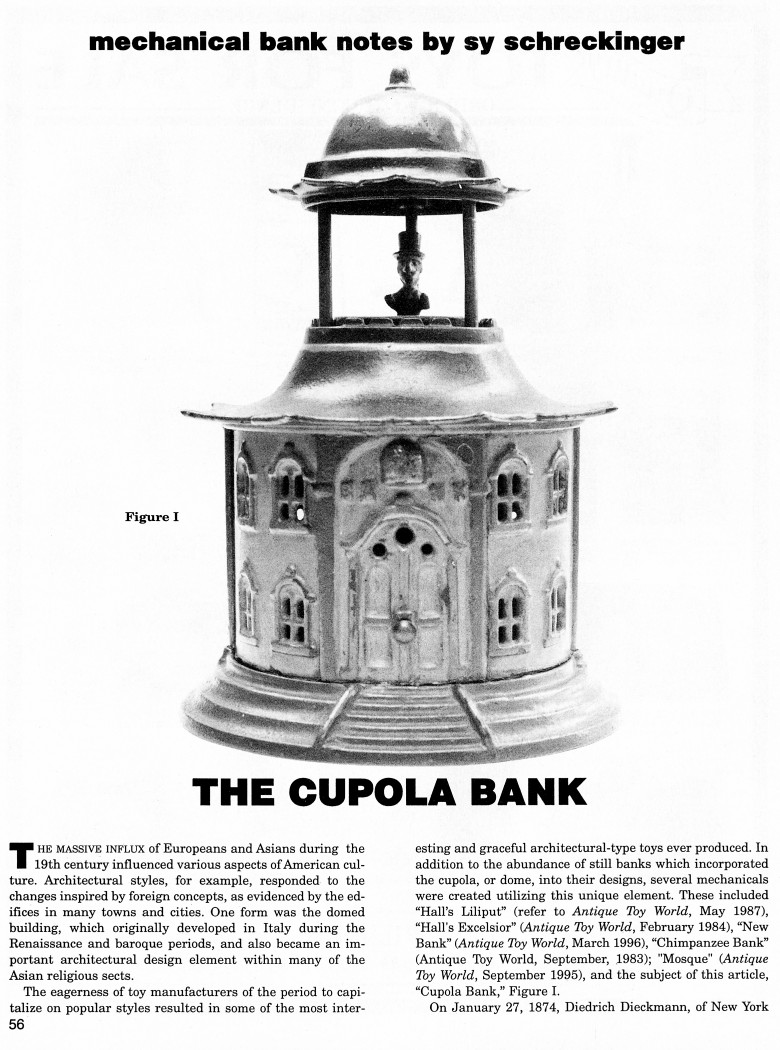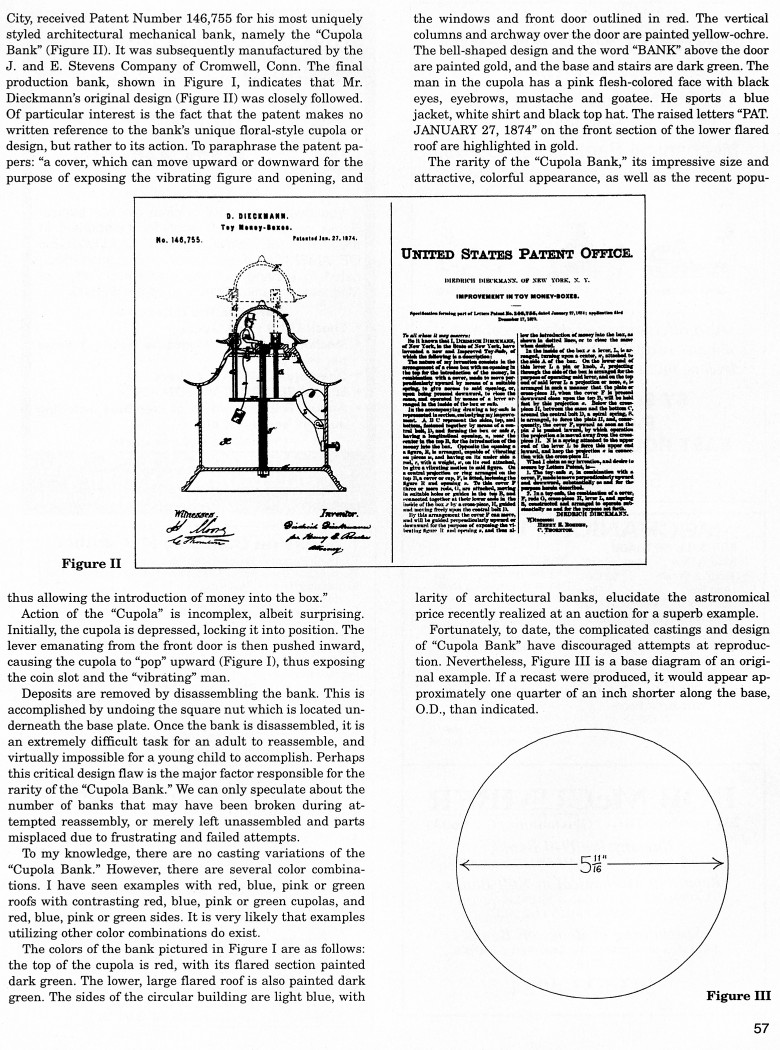|
The Cupola Bank
by Sy Schreckinger – ANTIQUE TOY WORLD Magazine – August, 1996
The massive influx Europeans and Asians during
the 19th century influenced various aspects of American culture.
Architectural styles, for example, responded to the changes inspired by
foreign concepts, as evidenced by the edifices in many towns and cities.
One form was the domed building, which originally developed in Italy
during the Renaissance and baroque periods, and also became an important
architectural design element within many of the Asian religious sects.
The eagerness of toy manufacturers of the period to capitalize on
popular styles resulted in some of the most interesting and graceful
architectural-type toys ever produced. In addition to the abundance of
still banks which incorporated the cupola, or dome, into their designs,
several mechanicals were created utilizing this unique element. These
included "Hall's Liliput" (refer to Antique Toy World,
May 1987), "Hall's
Excelsior" (Antique Toy World,
February 1984), "New Bank" (Antique Toy
World, March 1996), "Chimpanzee Bank" (Antique Toy World,
September,
1983); "Mosque" (Antique Toy World,
September 1995), and the subject of
this article, "Cupola Bank," Figure I.
On January 27, 1874, Diedrich Dieckmann, of New York City, received
Patent Number 146,755 for his most uniquely styled architectural
mechanical bank, namely the "Cupola Bank" (Figure II). It was subsequently
manufactured by the J. and E. Stevens Company of Cromwell, Conn. The final
production bank, shown in Figure I, indicates that Mr. Dieckmann's
original design (Figure II) was closely followed. Of particular interest
is the fact that the patent makes no written reference to the bank's
unique floral-style cupola or design, but rather to its action. To
paraphrase the patent papers: "a cover, which can move upward or downward
for the purpose of exposing the vibrating figure and opening, and thus
allowing the introduction of money into the box."
Action of the "Cupola" is incomplex, albeit surprising. Initially,
the cupola is depressed, locking it into position. The lever emanating
from the front door is then pushed inward, causing the cupola to "pop"
upward (Figure I), thus exposing the coin slot and the "vibrating" man.
Deposits are removed by disassembling the bank. This is accomplished
by undoing the square nut which is located underneath the base plate. Once
the bank is disassembled, it is an extremely difficult task for an adult
to reassemble, and virtually impossible for a young child to accomplish.
Perhaps this critical design flaw is the major factor responsible for the
rarity of the "Cupola Bank." We can only speculate about the number of
banks that may have been broken during attempted reassembly, or merely
left unassembled and parts misplaced due to frustrating and failed
attempts.
To my knowledge, there are no casting variations of the "Cupola
Bank." However, there are several color combinations. I have seen examples
with red, blue, pink or green roofs with contrasting red, blue, pink or
green cupolas, and red, blue, pink or green sides. It is very likely that
examples utilizing other color combinations do exist.
The colors of the bank pictured in Figure I are as follows: the top
of the cupola is red, with its flared section painted dark green. The
lower, large flared roof is also painted dark green. The sides of the
circular building are light blue, with the windows and front door outlined
in red. The vertical columns and archway over the door are painted
yellow-ochre. The bell-shaped design and the word "BANK" above the door
are painted gold, and the base and stairs are dark green. The man in the
cupola has a pink flesh-colored face with black eyes, eyebrows, mustache
and goatee. He sports a blue jacket, white shirt and black top hat. The
raised letters "PAT. JANUARY 27, 1874" on the front section of the lower
flared roof are highlighted in gold.
The rarity of the "Cupola Bank," its impressive size and attractive,
colorful appearance, as well as the recent popularity of architectural
banks, elucidate the astronomical price recently realized at an auction
for a superb example.
Fortunately, to date, the complicated castings and design of "Cupola
Bank" have discouraged attempts at reproduction. Nevertheless, Figure III
is a base diagram of an original example. If a recast were produced, it
would appear approximately one quarter of an inch shorter along the base,
O.D., than indicated.
|


